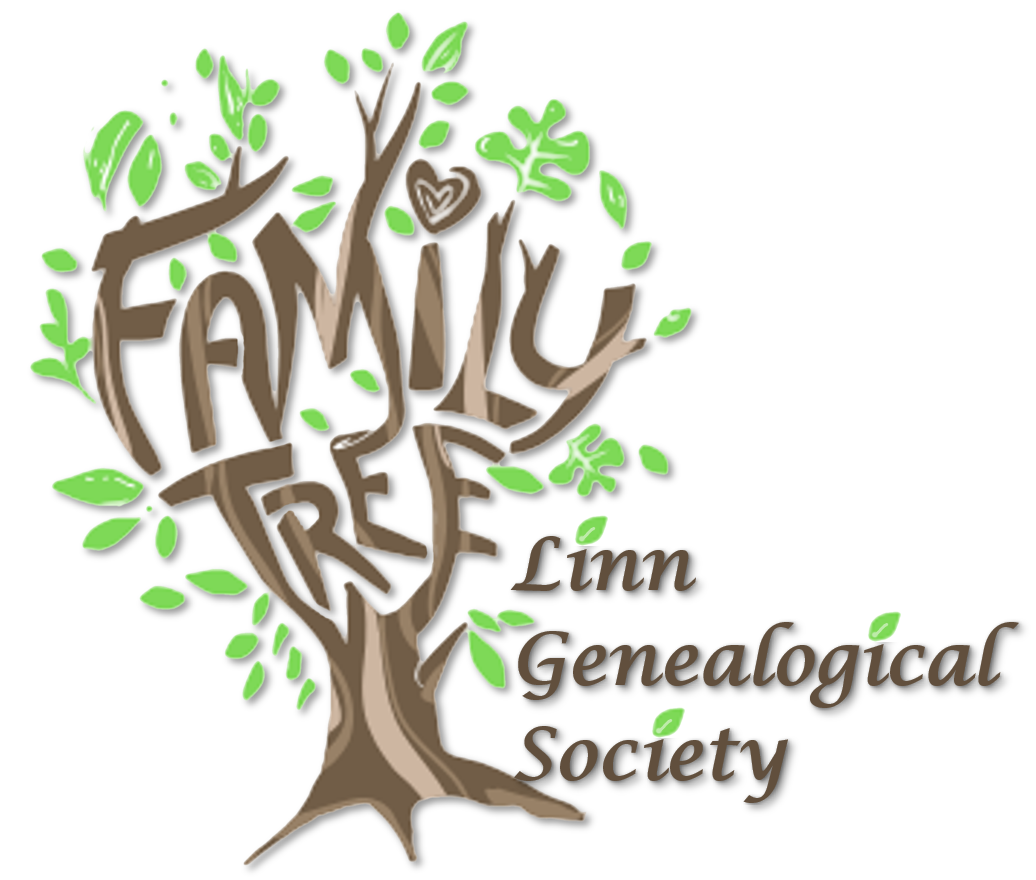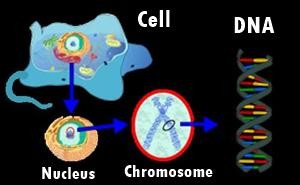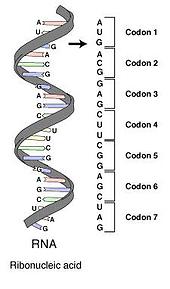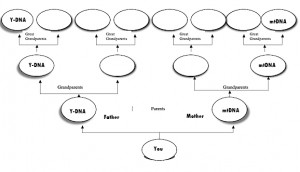Genealogy and DNA
Deoxyribonucleic Acid (DNA) testing can be confusing! Because of that I want to share what I have learned about DNA testing. First though it is important to understand just what is DNA.
DNA Structure and Function
Deoxyribonucleic acid is the genetic material that all living things carry in their cells. The cell’s nucleus and mitochondria contain the DNA. In essence, DNA can be thought of as a set of instructions that every cell in your body has and uses, it is essential for the synthesis of proteins and the division of cells.
Figure Credit: Magnus Manske Wiki Commons
Because you can’t see DNA it is an abstract concept, yet the structure of DNA is complex. To help understand how DNA is structured and functions it can be thought of as a computer file. Similar to a computer file, DNA is located in a specific place and contains specific information related to a particular purpose.
Deoxyribonucleic acid is made up of small units of base pairs of nucleic acids.[1] Nucleic acids are formed when nucleotides bond.[2]
Each nucleotide has three parts:
A five carbon sugar
A nitrogenous base
A phosphate (PO43-)[3]
When nucleotides bond, they are polymerized into something similar to a long chain. With DNA this chain takes the form of a double helix that is held together by nitrogen bases.
DNA can also be likened to a spiral staircase whose mainstay is a sugar phosphate structure. The ‘steps’ are nitrogen bases that are composed of either adenine (A) and thymine (T), or cytosine (C) and guanine (G).[4] According to Brennan and Demand, “The types and sequence of nucleotides in DNA determine the types and sequence of nucleotides in ribonucleic acid (RNA). This in turn determines the types and order of amino acids included in proteins.[5]”
Three nucleotides make up a codon. How base pairs are organized and structured in the condon, along with ribonucleic acid, informs the cell as to how to make new proteins that in turn determine our biological traits.[6] Both DNA and RNA have condons. The codons specify which amino acids (building blocks of protein) will be used in this process of protein building. [7] Like DNA, RNA is also a chain of nucleotides. However, RNA forms a single chain, not a double chain, and thymine is replaced by uracil (u).[8] The figure below represents a strand of RNA with its condons:
Figure Credit: Graham Beards Wiki Commons
RNA Structure and Function
Ribonucleic acid has three different types of structures:
Messenger RNA
Transfer RNA
Ribosomal RNA
Though the types of structure vary, each type is engaged with the synthesis of protein.[9] Simply put, when a cell wants to make protein, the enzyme helicase assists the DNA double helix in unwinding, so that DNA nucleotides are transcribe to a developing ‘thread’ of RNA.[10] This process is called transcription. After transcription, the DNA strand rewinds, and messenger RNA (mRNA) exports the DNA from the nucleus to the ribosomes.[11] Ribosomal RNA (rRNA) then decodes and uses the information from the condons “to add amino acids to a developing protein. chain.”[12] This continues until all of the mRNA has been decoded and the protein is fully synthesized.[13]
DNA: Generation to Generation
DNA carries its genetic code from one generation to the next through the chromosomes. In all, a person has 46 chromosomes that result in 23 chromosomal pairs, each pair consists of one chromosome from each parent. The chromosomes are thread-like structures that contain the DNA.[14] They can be thought of as hereditary ingredients that are passed from parents to offspring.
DNA Testing
Deciding what type of DNA test to take can be confusing. I hope this blog will provide some practical information so the reader can make informed choices about the types of tests to take, or if testing would even be worthwhile.
Y-DNA Testing
Y-DNA testing explores the father’s, father’s, father’s, etc genetic line. See the pathway of Y-DNA testing in the figure below. The Y-chromosome is passed down from father to son, usually unchanged, but mutations do occur. It is these mutations that make it possible for males to find both close and distant male relatives that have also tested. These mutations, known as Y-DNA Single Nuceotide Polymorphisms (SNP), are used as genetic markers. Y-DNA haplogroups are demarcated by the presence of particular Y-DNA SNP markers.
Y-DNA testing can assist in identifying one’s birthfather’s surname, or even the birthfather if he has tested. It is also useful for more distant studies of family relationships. People whose family lines, history and/or ethnic identity were broken or stolen through forced migration and bondage may be able to reconstruct some information about their family via Y-DNA testing. For example, many African Americans and Acadians had ruptures in their family lines. Y-DNA testing may reveal origins, and both close and more distant relatives. A good example of this is when Blair Underwood found a relative in Cameroon during an episode of Who do you Think you are.
Typically a man can chose to test 12, 25, 37, 67 or 111 markers. How many markers you test depends on your testing goals. If you test for 37 markers and match all 37 markers with someone, you have a 95% chance of having a common ancestor over the last 300 or so years. However, if you test for 67 markers and you match all markers with another tester, you have a 95% chance of having a common ancestor over the last 150 years. Family Tree DNA has a chart that indicates your level of relatedness for the 111 marker test. For example, if you match all 111 markers you will be a third cousins or closer. Testing large numbers of markers can be expensive, but if you start with 37 markers, you can add on to them if you find you have some identical or close genetic matches at 37 markers. If you test at the same company you only pay for the markers that are added on, not for a whole new test. The best place to test would be Family Tree DNA because it has the largest Y-DNA database in America; therefore, you are more likely to find matches. The testing company will let you know who your matches are. In their database you can choose to use your real name, a user name or hide your results from others. Many people adopt a user name.
mtDNA Testing
Mitochondrial DNA (mtDNA) testing is for males and females. Just as an FYI, men don’t pass their mtDNA to their children. mtDNA testing gives information about the direct maternal line, that is your mother’s mother’s, mother’s, etc line. mtDNA mutates much more slowly than Y-DNA so the mtDNA test is testing mtDNA that is thousands of years old. mtDNA testing will identify your maternal haplotype and the migration pathway of your matrilineal line will be mapped. It can be exciting to find out where your ancestors lived over time. mtDNA testing can help you break through maternal brick walls. Even if you can’t find your great grandmother’s maiden name, you may find who your GGGG grandmother was by matching with others. If you’re lucky, you may find someone who does know the maiden name of your great grandmother. Likewise, it may be possible to trace down the tree to your great grandmother if you know your GGGG grandmothers name.
Overall the significance of mtDNA testing is that if two people match at the HVR2 level, then those two people descend from a common female ancestor within the genealogical time-frame. That time-frame ranges from the current generation to up to 15 generations away. Because mtDNA mutates so slowly and it tests so far back in time, it is not recommended for people trying to find their biological mother.
I would recommend testing both HVR1 and HVR2 as HVR1 results are not very meaningful. You will have a lot of matches at HRV1, but they will mostly be with people who are outside of the genealogical timeframe. The HVR2 test provides more refined geographic origins information. HVR2 testing will eliminate matches that fall outside of the genealogical timeframe. You can also do a full mtDNA sequence test but not many people have done so yet, so you may find no or few matches right no, but in time the database will grow. The full sequence matches you find will be much closer matches than at the HVR2 level. The more refined haplogrouping that the full sequencing will provide, will better define your maternal migration path as every subclade has a unique migration history. The best place to test would be Family Tree DNA because it has the largest mtDNA database in America.
Autosomal DNA Testing
Though Y-DNA and mtDNA testing can determine one’s origins by going back thousands of years on the direct maternal and paternal lines, these types of tests exclude everyone else that contributed to one’s genetic makeup. This is where autosomal DNA testing comes in. Autosomal DNA testing can analyze one’s genetic blueprint, but it has it limits. For example, if you want to identify if you have a Native American connection, the full blooded connection would have to have been within the last 4 – 6 generations. If not, it is not likely to show in your autosomal DNA results. It could be that an individual had a Native American connection, but if it was not through a father’s father or a mother’s mother, and it was more than 4 – 6 six generations away, this connection would not be revealed through DNA testing.
Diagrams from the Genetic Genealogy Ireland website indicate the pathway of autosomal testing and also for Y-DNA and mtDNA testing. The best place to test in terms of numbers of people already tested for autosomal DNA is 23andme. Ancestry.com though has a growing database of testers.




